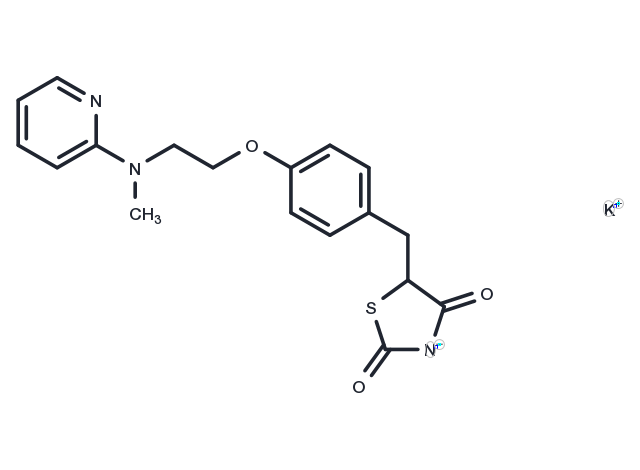Powder: -20°C for 3 years | In solvent: -80°C for 1 year


Rosiglitazone (BRL 49653) potassium is a potent and selective PPARγ agonist (EC 50: 60 nM, Kd: 40 nM), administered orally. It also serves as an activator of TRPC5 (EC 50: 30 μM) and an inhibitor of TRPM3. This compound, widely used in research, has shown promise in investigating obesity, diabetes, senescence, and ovarian cancer [1] [2] [4] [7].

| Pack Size | Availability | Price/USD | Quantity |
|---|---|---|---|
| 5 mg | 35 days | $ 78.00 | |
| 10 mg | 35 days | $ 153.00 | |
| 50 mg | 35 days | $ 595.00 | |
| 100 mg | 35 days | $ 1,060.00 |
| Description | Rosiglitazone (BRL 49653) potassium is a potent and selective PPARγ agonist (EC 50: 60 nM, Kd: 40 nM), administered orally. It also serves as an activator of TRPC5 (EC 50: 30 μM) and an inhibitor of TRPM3. This compound, widely used in research, has shown promise in investigating obesity, diabetes, senescence, and ovarian cancer [1] [2] [4] [7]. |
| In vitro | Rosiglitazone potassium, across various concentrations and incubation periods, exhibits diverse biological activities. At concentrations ranging from 0.1-10 μM over 72 hours, it promotes the differentiation of pluripotent C3H10T1/2 stem cells into adipocytes. When used at 1 μM for 24 hours, it activates PPARγ, leading to the binding of this receptor to the NF-α1 promoter and the subsequent activation of gene transcription in neurons. Additionally, this concentration and incubation time frame protect Neuro2A cells and hippocampal neurons from oxidative stress by up-regulating BCL-2 expression in an NF-α1-dependent manner. At a range of 0.01-100 μM for 15 minutes, it inhibits TRPM3 channels, demonstrating IC 50 values of 9.5 μM and 4.6 μM against nifedipine- and PregS-evoked activities, respectively. Furthermore, concentrations between 0.5-50 μM over seven days have been shown to inhibit ovarian cancer cell proliferation, while a specific dosage of 5 μM for the same duration counters Olaparib-induced cellular senescence alterations and encourages apoptosis in A2780 and SKOV3 cells. This effect on cell proliferation and apoptosis is supported by Cell Proliferation Assay results, which show a time and concentration-dependent inhibition of cell proliferation in A2780 and SKOV3 cells. Western Blot Analysis further corroborates these findings, indicating increased levels of NF-α1 and BCL-2 proteins in hippocampal neurons treated with 1 μM of rosiglitazone potassium for 24 hours. |
| In vivo | Rosiglitazone potassium, when administered orally at 5 mg/kg daily for 8 weeks, was observed to reduce serum glucose levels in diabetic rats. This same compound, when given through intraperitoneal injection at 3 mg/kg/day, effectively mitigated airway inflammation in male Wistar rats by inhibiting M1 macrophage polarization through the activation of PPARγ and RXRα, a process induced by cigarette smoke exposure. Additionally, a dosage of 10 mg/kg administered intraperitoneally every two days demonstrated a significant inhibition of subcutaneous ovarian cancer growth in A2780 and SKOV3 mouse subcutaneous xenograft models. Detailed evaluations indicated that, in streptozotocin (STZ)-induced diabetic rats, the oral administration led to decreased IL-6, TNF-α, and VCAM-1 levels, along with reduced lipid peroxidation and NOx levels, while also increasing aortic GSH and SOD levels. Similarly, in male Wistar rats, the compound, when injected intraperitoneally twice a day for six days a week over 12 consecutive weeks, not only ameliorated emphysema symptoms and improved pulmonary function but also reduced the total cells, neutrophils, and cytokines (TNF-α and IL-1β) elevated by cigarette smoke. This treatment effectively inhibited cigarette smoke-induced M1 macrophage polarization and decreased the M1/M2 ratio. |
| Molecular Weight | 395.52 |
| Formula | C18H18KN3O3S |
| CAS No. | 316371-84-3 |
Powder: -20°C for 3 years | In solvent: -80°C for 1 year
You can also refer to dose conversion for different animals. More
bottom
Please see Inhibitor Handling Instructions for more frequently ask questions. Topics include: how to prepare stock solutions, how to store products, and cautions on cell-based assays & animal experiments, etc.
Rosiglitazone potassium 316371-84-3 inhibitor inhibit
